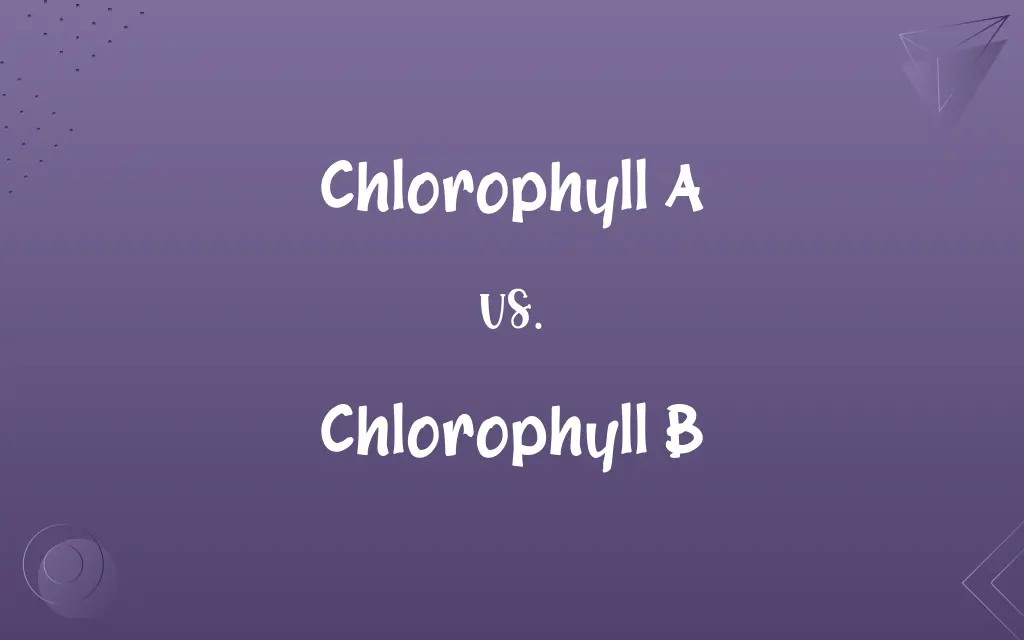Chlorophyll A vs. Chlorophyll B: Know the Difference

By Shumaila Saeed || Updated on December 25, 2023
Chlorophyll A serves as the Primary pigment in photosynthesis, absorbs mainly blue and red light. Chlorophyll B acts as an accessory pigment, absorbs blue and red-orange light, complements Chlorophyll A.

Key Differences
Chlorophyll A is the primary pigment in the photosynthesis process, essential for capturing light energy. Chlorophyll B, on the other hand, serves as an accessory pigment, broadening the spectrum of light a plant can use.
Shumaila Saeed
Dec 16, 2023
In terms of structure, Chlorophyll A has a methyl group (-CH3) in its composition. In contrast, Chlorophyll B contains an aldehyde group (-CHO), differentiating it chemically and functionally from Chlorophyll A.
Shumaila Saeed
Dec 16, 2023
Chlorophyll A absorbs light predominantly in the blue-violet and red regions, making it directly involved in the conversion of solar energy to chemical energy. Chlorophyll B, however, primarily absorbs blue and red-orange wavelengths, thus aiding Chlorophyll A in photosynthesis.
Shumaila Saeed
Dec 16, 2023
Regarding their roles, Chlorophyll A is indispensable for initiating the reaction in the photosystem. Chlorophyll B, while not directly involved in the conversion of light energy, assists in capturing additional light wavelengths.
Shumaila Saeed
Dec 16, 2023
Finally, in energy transfer, Chlorophyll A is the central molecule that transfers absorbed energy in the photosystem. In comparison, Chlorophyll B transfers the absorbed energy to Chlorophyll A, supporting the overall process.
Shumaila Saeed
Dec 16, 2023
ADVERTISEMENT
Comparison Chart
Primary Role
Main photosynthetic pigment
Accessory pigment, complements Chlorophyll A
Shumaila Saeed
Dec 16, 2023
Light Absorption
Absorbs mainly blue-violet and red light
Absorbs mainly blue and red-orange light
Shumaila Saeed
Dec 16, 2023
Molecular Structure
Contains a methyl group (-CH3)
Contains an aldehyde group (-CHO)
Shumaila Saeed
Dec 16, 2023
Role in Photosynthesis
Directly involved in energy conversion
Aids in capturing additional light wavelengths
Shumaila Saeed
Dec 16, 2023
Energy Transfer
Central molecule in energy transfer
Passes absorbed energy to Chlorophyll A
Shumaila Saeed
Dec 16, 2023
ADVERTISEMENT
Chlorophyll A and Chlorophyll B Definitions
Chlorophyll A
Absorbs mainly blue and red light.
The presence of Chlorophyll A is why plants appear green, as it reflects green light.
Shumaila Saeed
Dec 11, 2023
Chlorophyll B
Contains an aldehyde group, differing from Chlorophyll A.
The structural difference in Chlorophyll B, compared to A, allows it to capture a broader range of light.
Shumaila Saeed
Dec 11, 2023
Chlorophyll A
Central in converting light energy to chemical energy.
Chlorophyll A is key in the process of transforming sunlight into usable energy for the plant.
Shumaila Saeed
Dec 11, 2023
Chlorophyll B
Absorbs light in the blue and red-orange spectrums.
Chlorophyll B's ability to absorb different light spectrums enhances the plant's photosynthetic efficiency.
Shumaila Saeed
Dec 11, 2023
Chlorophyll A
Essential for the photosynthetic reaction center.
Without Chlorophyll A, the plant cannot perform photosynthesis effectively.
Shumaila Saeed
Dec 11, 2023
ADVERTISEMENT
Chlorophyll B
Enhances the range of light a plant can use.
Chlorophyll B broadens the spectrum of light that plants can utilize for energy production.
Shumaila Saeed
Dec 11, 2023
Chlorophyll A
Found in all photosynthetic organisms, including algae.
Chlorophyll A is present not only in plants but also in algae, facilitating photosynthesis.
Shumaila Saeed
Dec 11, 2023
Chlorophyll B
Transfers absorbed energy to Chlorophyll A.
Chlorophyll B plays a supporting role by funneling energy to Chlorophyll A in the photosystem.
Shumaila Saeed
Dec 11, 2023
Chlorophyll A
Primary photosynthetic pigment in plants.
Chlorophyll A plays a crucial role in converting sunlight into energy in plants.
Shumaila Saeed
Dec 11, 2023
Chlorophyll B
Accessory pigment in photosynthesis.
Chlorophyll B assists Chlorophyll A by capturing additional light wavelengths.
Shumaila Saeed
Dec 11, 2023
Repeatedly Asked Queries
What color light does Chlorophyll A absorb?
Primarily blue-violet and red wavelengths.
Shumaila Saeed
Dec 16, 2023
How does Chlorophyll A work in photosynthesis?
It captures light energy and initiates the conversion to chemical energy.
Shumaila Saeed
Dec 16, 2023
Can plants survive without Chlorophyll A?
No, it's essential for photosynthesis.
Shumaila Saeed
Dec 16, 2023
What is Chlorophyll A?
A primary pigment in photosynthesis, absorbing blue and red light.
Shumaila Saeed
Dec 16, 2023
Is Chlorophyll A found in all plants?
Yes, it's present in all photosynthetic plants and algae.
Shumaila Saeed
Dec 16, 2023
What is the molecular difference between Chlorophyll A and B?
Chlorophyll A has a methyl group, while B contains an aldehyde group.
Shumaila Saeed
Dec 16, 2023
Which chlorophyll is more abundant in plants?
Chlorophyll A is typically more abundant.
Shumaila Saeed
Dec 16, 2023
What is Chlorophyll B?
An accessory pigment that complements Chlorophyll A in photosynthesis.
Shumaila Saeed
Dec 16, 2023
Can Chlorophyll B function without Chlorophyll A?
No, it's an accessory and relies on Chlorophyll A.
Shumaila Saeed
Dec 16, 2023
What role does Chlorophyll B play in light absorption?
It broadens the range of light that plants can utilize.
Shumaila Saeed
Dec 16, 2023
How does Chlorophyll B support Chlorophyll A?
By absorbing additional light wavelengths and transferring energy to Chlorophyll A.
Shumaila Saeed
Dec 16, 2023
Do all plants have Chlorophyll B?
Most, but not all; it's more common in green plants.
Shumaila Saeed
Dec 16, 2023
Does Chlorophyll B participate directly in energy conversion?
No, it assists in capturing light but doesn't convert energy itself.
Shumaila Saeed
Dec 16, 2023
Are Chlorophyll A and B found in aquatic plants?
Yes, they are present in both terrestrial and aquatic photosynthetic organisms.
Shumaila Saeed
Dec 16, 2023
What is the significance of Chlorophyll A in ecosystems?
It's vital for primary production and oxygen generation.
Shumaila Saeed
Dec 16, 2023
Can Chlorophyll B replace Chlorophyll A?
No, each has distinct and complementary roles.
Shumaila Saeed
Dec 16, 2023
What happens if a plant lacks Chlorophyll B?
It may have reduced efficiency in capturing light energy.
Shumaila Saeed
Dec 16, 2023
Can Chlorophyll A and B be used in solar energy research?
Yes, their light-absorbing properties are studied for potential solar energy applications.
Shumaila Saeed
Dec 16, 2023
How are Chlorophyll A and B similar?
Both are involved in photosynthesis and absorb light.
Shumaila Saeed
Dec 16, 2023
Do Chlorophyll A and B have health benefits for humans?
Indirectly, as they are crucial for producing the oxygen we breathe and the plants we consume.
Shumaila Saeed
Dec 16, 2023
Share this page
Link for your blog / website
HTML
Link to share via messenger
About Author
Written by
Shumaila SaeedShumaila Saeed, an expert content creator with 6 years of experience, specializes in distilling complex topics into easily digestible comparisons, shining a light on the nuances that both inform and educate readers with clarity and accuracy.









































































